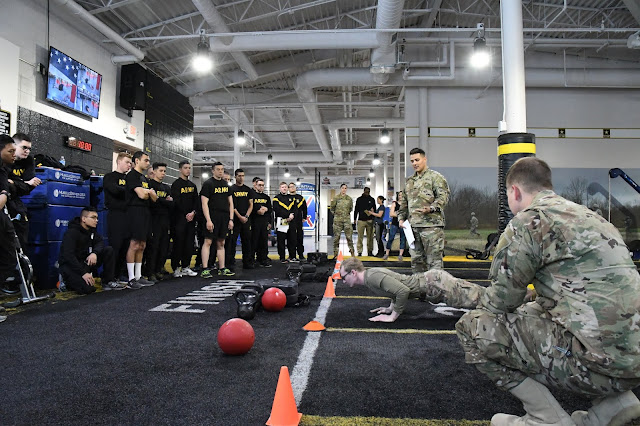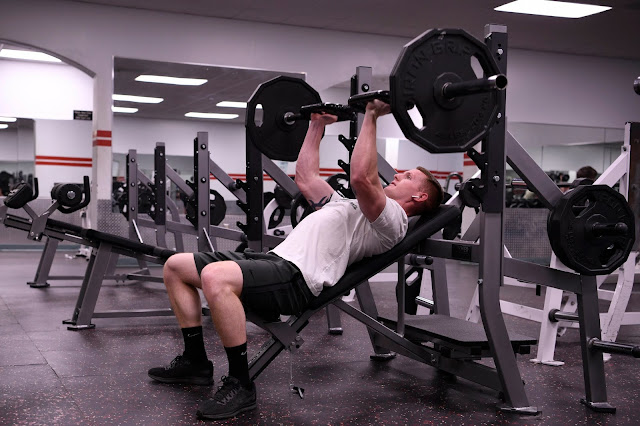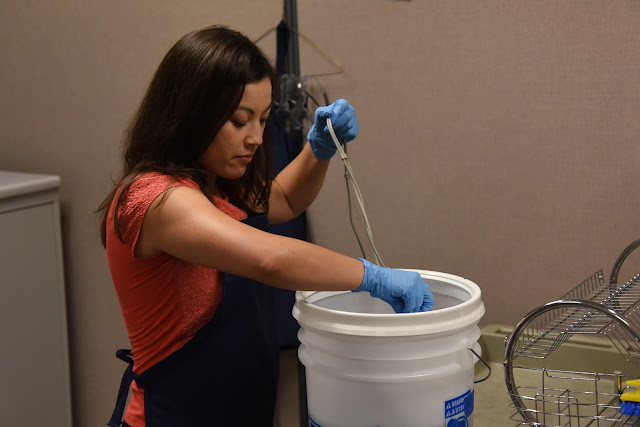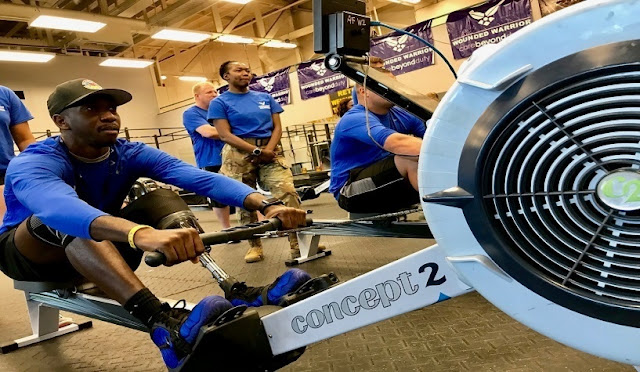10th Mountain Division Soldiers finding resourceful ways to tackle ACFT training
Story by Michael Strasser
Fort Drum Garrison Public Affairs
Dozens of Soldiers from 1st Battalion, 87th Infantry Regiment, 1st Brigade Combat Team, were pulling weighted sleds, running with kettlebells and cranking out deadlifts at the gym one recent frosty morning at Fort Drum.
This is nothing new or particularly eye-catching at Atkins Functional Fitness Facility where such activity is common, and patrons can rope climb, flip tires and row to their heart’s content.
What was different was their reason why.
As Soldiers from across the 10th Mountain Division (LI) condition themselves for the new Army Combat Fitness Test, many are finding the space at Atkins to be the best training grounds until the snow melts and temperatures rise above freezing.
“With our training schedule and deployments, we are trying to do what we can now so everyone can be successful on the ACFT,” said Staff Sgt. Sergio Castillo, with B Company, 1st Battalion, 87th Infantry Regiment, 1st Brigade Combat Team. “Especially now with the winter weather, and (preparing for) our JRTC (Joint Readiness Training Center) rotation, that can be challenging.”
Castillo said that Soldiers in each platoon of his company are receiving familiarization training on each of the ACFT events – the deadlift, power throw, hand-release pushups, sprint-drag-carry, leg tuck and two-mile run. They also will complete the full ACFT – not for record, but to inform their leadership about their performance percentages and areas for improvement.
“My goal is to make sure that our Soldiers know what is expected of them, so the next time they take this test it won’t be a shock to them,” he said. “Our company is going to have the knowledge they need and the time they need to prepare for it.”
The ACFT is slated to become the test of record in October 2020.
The 1-87 Infantry is among 62 battalions throughout the Army selected to participate in a yearlong pilot for the ACFT. Between March and October, selected units will take two not-for-record ACFTs, after which the entire Army will take two not-for-record ACFTs roughly six months apart.
When a mobile training team arrived at Fort Drum late last year, Castillo completed the Level III certification that allows him to oversee the ACFT, and train and certify others in his unit to administer and grade the test.
“Personally, I like the ACFT more than the APFT,” he said. “Everything that is implemented in the ACFT we use in training and in combat. When I teach Soldiers, I want them to see how it all relates.”
Castillo said that because the ACFT is more intense than the current Army Physical Fitness Test, he is seeing some Soldiers struggle early on.
“That’s because a lot of us don’t train this way, and we don’t usually focus on this type of workout during normal PT hours,” he said. “With the APFT, we didn’t have to.”
The major difference between the ACFT and the APFT is that the new test requires Soldiers to complete more events – six – in a shorter amount of time. Some events require kettlebells and a weighted hex bar, whereas the APFT required only a Soldier’s body weight. The ACFT targets every major muscle group in the body and aligns fitness with combat readiness in ways that the APFT can’t assess.
“The sprint-drag-carry alone is taking a lot of guys out,” he said. “This event is the peak of the ACFT, because by the time Soldiers get to this event they have already depleted a lot of energy in their legs, shoulders and chest, and they have that elevated heart rate.”
“We don’t want to see any Soldiers passing out or getting hurt because they aren’t prepared,” he added.
Capt. Shana Lilley, 1-87 Infantry physical therapist, watched as Soldiers performed each event during a recent session at Atkins and advised them of any adjustments they could make to prevent injuries.
“The ACFT necessitates a shift in how we train,” she said. “This includes our physical training, nutrition and mental skills.”
The current Army Physical Fitness Test grades Soldiers differently based on age and gender, which will not be the case with the ACFT. Lilley said that the difference will challenge many Soldiers, but it is an important change for combat readiness.
“We have found that the Soldiers – regardless of rank and time in service – who have a higher fitness level and positive attitude toward the new test are thriving with the new standards,” she said. “The Soldiers who have lower fitness levels and negative attitudes toward the test are more resistant to the change. Fortunately, many of our Soldiers have expressed positive feelings toward the test since it is more challenging.”
Lilley said that given the limitations of the current field training tempo and access to indoor facilities in inclement weather, it has been difficult to build a training program that completely encompasses the six-event test.
“But I think that Soldiers should still be able to pass this test,” she said. “The events themselves are more challenging and more holistic than the previous test, but it is attainable. It will be more difficult to max, but anyone who wears the uniform should be able to pass this test.”
For that reason, Castillo is using all of the resources available to get Soldiers ready, which includes 1-87 Infantry’s Team APEX (Army Performance Experts) that consists of two strength and conditioning coaches, a physical therapist, an occupational therapist and a dietitian.
“That’s a great advantage to us for Soldiers who don’t know the proper form for these events, or don’t understand that what they eat will affect them during the test,” he said.
Lilley said that Soldiers have been working closely with Team APEX, but for the most part the NCOs within each company have taken the lead in ACFT training.
“It is important that we empower the leaders in our unit to train their Soldiers, and you can see how well the Soldiers respond to the NCOs’ instruction.” she said. “It’s not mandatory, but we strive to have at least one member – and ideally all – of our Team APEX present at each training event. It provides us the opportunity to mentor the NCOs who are teaching, observe the Soldiers as they perform each task, and inform the Soldiers of the resources that we provide.”
Lindsey Craft, strength and conditioning coach, said that the goal is to have Soldiers focus on developing general physical capacities – agility, power, strength, anaerobic endurance and aerobic endurance.
“By building these general capacities, not only will they improve on the ACFT, but we can improve Soldier readiness year round and increase their performance level for any test or school,” she said. “By creating a buffer of these general capacities, they become more resistant to arduous conditions and stressors, so they can repeatedly deliver above the standard.”
Craft noted that many Soldiers had questions about grading standards for the ACFT, but they were also interested in learning more about nutrition.
“Performance nutrition took center stage, as many Soldiers are finding out their typical morning routine provides insufficient energy, hydration and digestion time when applied to the ACFT,” she said.
During one session, 1st Lt. Kelly Schaad, 1-87th Infantry dietitian, advised Soldiers to think ahead about fueling their bodies for the ACFT and not rely on what worked for them for APFTs.
“Obviously, this test is a little more involved, and some of you probably didn’t have to train as hard for the APFT,” she said. “So we want you to be aware of the different energy systems you will be using during the ACFT and how to properly fuel to maximize the potential of these energy systems.”
The phospagen energy system is used for moments requiring short bursts of energy, and Schaad said that when Soldiers perform the first event – the deadlift – they will initially use muscle phosphocreatine stores for energy.
The events that follow the deadlift rely primarily on muscle stores of glycogen for energy, as the anaerobic and aerobic energy systems prefer to use carbohydrates to produce moderate amounts of energy for longer amounts of time. Carbohydrates are stored as glycogen in the body, which is necessary for fueling muscle contractions. Insufficient carbohydrate intake will hinder a Soldiers ability to sustain heavy loads, mental agility, and power during moderate- to high-intensity activity such as the ACFT.
“That’s why it is really important to fuel up on carbs before taking the test, because you need glycogen to provide energy during these events,” Schaad said. “We see many Soldiers who do not do a lot of anaerobic training that will burn through that energy system fairly quickly.”
After five events, without proper fueling beforehand, the two-mile run is going to use up glycogen stores and begin using fat and protein to provide energy.
“The body doesn’t convert those to energy as easily, so you’re going to find it harder to perform as well,” Schaad said. “If you’ve ever rucked more than six miles or run long distances, you may have experienced the hitting-the-wall feeling where you have symptoms of muscle weakness and fatigue. This is the point of glycogen depletion. That’s why before going into this test we want to make sure you maximize glycogen stores, so you can perform more efficiently.”
For most service members, physical fitness training and testing occur in the early morning. This can be a challenge to maintaining proper energy levels, because carbohydrate stores are used to maintain normal blood glucose levels during sleep. First thing in the morning, glycogen stores are typically low and in need of replenishment. While some Soldiers may avoid eating or drinking prior to a physical event for fear of stomach discomfort, a small snack can go a long way to benefit their overall performance.
Schaad recommended eating complex carbohydrates such as a medium-sized fruit or granola bar an hour before taking the ACFT. For Soldiers who typically skip breakfast before PT in the morning, an easily digestible snack like toast or a fruit smoothie will serve as a great option. These Soldiers should practice introducing foods at least several weeks prior to a big event such as the ACFT.
In a time crunch, Soldiers can opt for an energy gel or a quarter bottle of a sports drink about 30 minutes before taking the test.
Adequate – but not excessive – hydration is also key for performing well on physical competitions such as the ACFT. A Soldier can typically expect to see a decrease in performance with as little as two to three percent of their body weight loss from sweat.
In the days leading up to the ACFT, Soldiers should avoid substances that will dehydrate them, such as caffeine and alcohol. Soldiers should drink to quench thirst level in the days leading up to the ACFT. If performing strenuous activity during that time, they should consider using sports drinks to replenish electrolyte levels, which will help ensure the body is adequately hydrated.
“The ACFT will serve a wake-up call for many Soldiers who currently are just getting by with mediocre nutrition, hydration, exercise, and sleep habits,” Schaad said. “In our trial runs of the ACFT, we have already seen Soldiers who failed to complete the events or were unable to perform to their full potential due to poor eating and hydration habits prior to the test.”
Some Soldiers struggle to consume a nutritious meal throughout the day. Schaad said that they often report skipping meals or choosing fast food options due to time constraints.
“Part of our job, as a team of performance experts, is to teach Soldiers to rethink the way they make decisions,” she said. “This might include anything from teaching Soldiers to complete a dynamic warmup before exercising to teaching meal planning and nutrient timing.”
In that way, the ACFT will help emphasize the importance of planning and learning how to overcome barriers.
“Although the ACFT is a tougher test, the Army has invested in a holistic health and fitness program, which will build Soldiers who are combat effective and who can overcome adversity in order to perform at a higher level,” Schaad said. “These are the Soldiers that you want to go to war with. The goal of Team APEX and other holistic health and fitness teams across the Army is to shift the Soldier mindset toward the proper planning and prevention strategies in order to build a force that is physically ready and resilient.”




Comments
Post a Comment